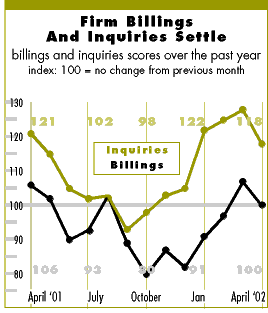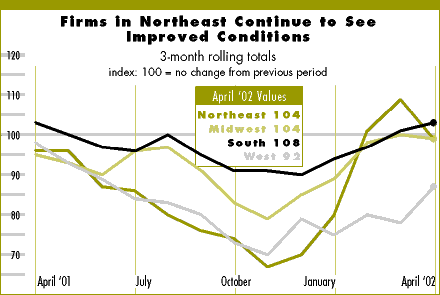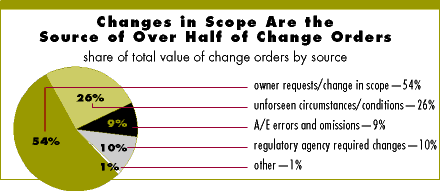
Owner changes in scope leading source of change orders

Work-on-the-Boards Survey
by Kermit Baker, PhD, Hon. AIA
AIA Chief Economist
Business conditions during April provide continued evidence that the recession for U.S. architecture firms has ended. They also offer evidence that the recovery is likely to be slow in unfolding. After a strong gain in March, billings at architecture firms remained stable in April. Inquiries for new projects, which had shown strong gains through the first three months of the year, rose at a somewhat slower pace in April.
 Regionally,
business patterns at firms remained largely unchanged. Firms in the Northeast
continue to report strong improvement in business conditions, firms in
the Midwest and South report modest gains, while those in the West still
report a modest slowdown. Residential firms (those with over 50% of their
billings in the residential sector) reported a sharp increase in billings
and an even sharper rise in inquiries for new projects. Commercial/industrial
firms report stable billings and a modest increase in inquiries. Institutional
firms reported a rare dip in billings in April, and no increase in inquiries.
Regionally,
business patterns at firms remained largely unchanged. Firms in the Northeast
continue to report strong improvement in business conditions, firms in
the Midwest and South report modest gains, while those in the West still
report a modest slowdown. Residential firms (those with over 50% of their
billings in the residential sector) reported a sharp increase in billings
and an even sharper rise in inquiries for new projects. Commercial/industrial
firms report stable billings and a modest increase in inquiries. Institutional
firms reported a rare dip in billings in April, and no increase in inquiries.
The economy performed surprisingly well in the first quarter according to a recently released report on GDP, which showed the economy growing by 5.8% when annualized. However, the second quarter seems to be moving at a somewhat slower pace. The employment report for April showed national unemployment jumping to 6.0% from 5.7% in March. Business payrolls grew slowly in April, while payrolls for construction companies took a sharp decline.

Consumer confidence also dipped in bit in April, after strong gains in March. Hopefully this decline in confidence won't hurt the housing sector. Housing continues to be a bright spot in the economy, averaging 1.72 million starts for the first quarter (annualized), 5% above the level of the first quarter of 2001. The rest of the construction industry isn't doing quite so well. F.W. Dodge reported that contracts for nonresidential building declined 11% in March from February levels. For the first quarter, however, nonresidential construction contracts were up slightly over first quarter 2001 levels.
Owners generate most
change orders
The special topic question for this month followed up on last month's
question about change orders; namely to discover their source. On average,
firms reported that just over half (54%) of the total value of change
orders were from owner requests or changes in the scope of work. Unknown
or unforeseen circumstances or conditions, often at the work site, generated
the next largest share, on average accounting for just over a quarter
of the total value of change orders. Regulatory agency-required changes
were next, accounting for just over 10% of the total value of change orders.
A/E errors and omissions averaged less than 10% of the total, according
to our Work-on-the-Boards panel. Other factors, such as problems obtaining
specified products or materials, accounted for less that 1% of the total.

Many panelists noted that there can be tremendous variation in these shares depending on the type, scope, and size of the project. Some also commented that there can be a difference in competitive bid projects compared to negotiated projects. Also, many observed that for renovation projects, a higher share of change orders is for unknown or unforeseen conditions in the existing structure.
Copyright 2002 The American Institute of Architects. All rights reserved.
![]()
|
This month, Work-on-the-Boards survey participants are saying: "Our expectation is that the rebound
will be more difficult to achieve than the business press seems
to be indicating." "Many more prospects are before
us since we are aggressively seeking new work." This Just In Baker and Murray to present construction outlook on May 11—click for details. |
|